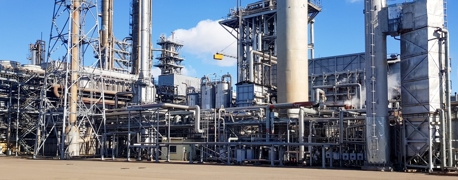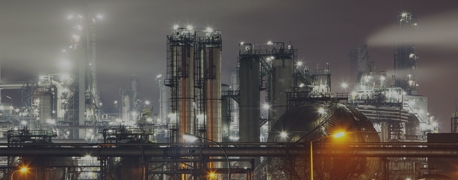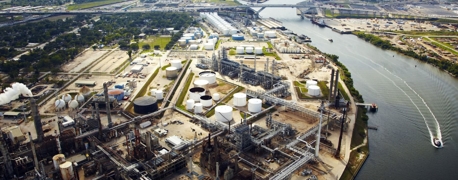History's Worst Chemical Plant Accidents

Toxic chemicals. Intense fires. Sudden explosions. Chemical plant accidents are the worst events workers and families will ever have to experience.
Aging equipment and poorly trained managers cause catastrophic damage, fatalities, severe injuries, and unimaginable grief. Chemical exposure creates immediate injuries and long-term illness, while explosions can leave people with irreparable scars.
Below, we look at the worst chemical plant disasters in U.S. history and examine what caused them.
The Worst Chemical Plant Disasters in U.S. History
Chemical plant explosions and fires are more common than you think—many of which occur in the southern energy corridor of the United States. Every year industrial chemical manufacturers put their own employees and individuals in surrounding communities in harm's way by not safely and properly running their chemical plants. Even worse, many try to evade responsibility after the fact. Trillions of dollars have been spent on cleaning up preventable mistakes, which have impacted thousands of lives—by death and property destruction.
Thiokol-Woodbine Explosion – February 3, 1971
In Woodbine, GA, a chemical plant was set on fire and later exploded on February 3, 1971. The plant was operated by Thiokol Chemical at the time of the accident and was composed of more than 35 buildings on a facility that stretched for 7,400 acres of Georgia land. The fires occurred in building M-132, which was large and without windows. The fires were started where an ignition chemical was added to other chemicals; while other small fires were not rare, this one quickly proved to be different as it jumped to the conveyor belt and spread throughout the building. Within minutes of the fire beginning, all 80 workers evacuated the building but did not leave the general area. The fire then reached the plant's storage rooms, which caused the blast.
The results were catastrophic, with 24 people dying during the explosion or immediately after, 5 dying later from related injuries, and at least 50 others suffering catastrophic and life-changing injuries.
Henderson Rocket Fuel Plant Explosion – May 4, 1988
The Henderson, Nevada rocket fuel (ammonium percolate) plant explosion in the below video registered 3.5 on the Richter scale and was felt 600 miles away. The explosion decimated the $100 million plant, which made rocket fuel for the U.S. space shuttle program. At the time of the event, the space shuttle program was on hold because of the Challenger disaster two years earlier. But work at the Henderson plant continued apace and eventually, the plant ran out of containers. In building new storage containers, welders are believed to have ignited existing drums of ammonium percolate. The site was filled with many sealed bins, some stacked on top of others, covering an area the size of a football field. Once the first explosion occurred, a chain reaction soon followed.
The accident killed 2 people, injured 372 people, and caused an estimated $100M worth of damage.
Phillips Disaster – October 23, 1989
On October 23, 1989, a series of explosions and a fire occurred at a Houston Chemical Complex (HCC) facility in Pasadena, TX that was producing high-density polyethylene (HDPE). The accident occurred during routine maintenance at the plant when air connections for opening and closing the valve were reversed—releasing 85,000 pounds of flammable gases instantly. The gas traveled through the plant and within two minutes came into contact with an ignition source and exploded. Somewhere between 10 to 15 minutes later, a storage tank exploded, which was followed by several other blasts throughout the plant. The explosions initially registered 3.5 on the Richter Scale and the fires took approximately 10 hours to bring back under control.
The fire and explosions killed 23 employees and injured nearly 315 other individuals.
Sterlington Plant Blast – May 1, 1991
A chemical plant owned by Angus Chemical of Northbrook, Ill and operated by IMC Fertilizer in Sterlington, LA suffered from a series of blasts. The accident caused both workers and local residents to suffer severe injuries and approximately 500-600 residents were immediately evacuated. The local area saw severe damage with buildings suffering blasted out windows, siding ripped from homes, and vehicles completely burned. Per the mayor, the business district was hit particularly hard. According to reports after the blast, a small fire was reported in the plant and blasts occurred about 30 seconds later, which could be heard 8 miles away.
The blast killed 8 of the workers at the plant and injured approximately 120 other people.
West Fertilizer Plant Explosion – April 2013
On April 17, 2013, an explosion at the West Fertilizer Company in West County, Texas killed 15 people, injured at least 200 more, and damaged 350 homes. The explosion occurred after a fire broke out in the plant caused by a faulty golf cart or electrical malfunction that ignited over 270 tons of ammonium nitrate manufactured on-site. Complaints of an ammonia smell led the TCEQ to and in the same year, the EPA fined the company for not having a risk management plan. In 2011, a later plan filed by the company did not mention that ammonium nitrate was stored at the facility. The blast blew out windows miles away and even registered as an earthquake. Investigators said it left a crater 10 feet deep and nearly 100 feet wide.
15 people were killed and at least 200 others were injured in this explosion.
Williams Olefins Plant Explosion – June 13, 2013
On June 13, 2013, a plant explosion occurred in Geismar, LA, which is roughly 20 miles outside of Baton Rouge. A preliminary findings report was issued, suggesting the incident was the result of a vapor cloud that formed after a re-boiler ruptured. The vapor cloud was then ignited within seconds by an unknown heat or flame source. Per reports following the blast, the accident was caused by the failure of a heat exchanger, which triggered investigations by both the U.S. Occupational Safety and Health Administration and the U.S. Chemical Safety and Hazard Investigation Board. The plant had been originally built by Allied Chemical in 1968 and was later transferred to Williams Olefins in 1999 where it was used to produce ethylene and propylene. The blasts could be felt for several miles outside of the chemical plant, and shelter-in-place orders were quickly issued.
The accident killed 2 workers and injured 114 other people.
Chevron Oil Explosion – August 2013
The Chevron refinery fire in Richmond, California was triggered by an old pipe, more than 30 years old and likely from the early 1970s. The pipe reportedly began leaking and leaked for two hours before it was discovered. Workers worked quickly to remove the insulation unit but did so while the pipe was still processing crude oil. This led to a spark and explosion in which five workers were treated for minor injuries. Huge plumes of burning chemicals filled the air and more than 15,000 local residents were treated at the hospital for inhalation of smoke and breathing problems.
The incident left 5 workers injured and sent over 15,000 residents to the hospital for treatment.
Our Accident Lawyers Have Secured Over $20 Billion for the Injured
Our chemical plant explosion lawyers fight for workers and workers’ families to ensure that they receive what they need to heal and move forward. Our firm has secured record-setting verdicts and settlements on behalf of bereaved families, recovering over $20 billion for our clients. As a result, our clients are able to pay for the medical care and losses that result from catastrophic injuries, chemical exposure, fatalities, and unimaginable grief. We believe each case helps future workers stay safe by sending a message to large corporations: value the lives of their employees above all else.
If you need the skill of an experienced industrial accident attorney, contact our firm today.
- Categories


